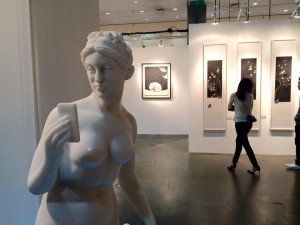Cultural Cocktail Hour
In the news: Selfies and artistic collateral damage
Selfies: Artistic Collateral Damage?
by
Leticia Marie Sanchez
This article first appeared in Cultural Cocktail Hour in 2016

One cannot enter a gallery, museum, or even concert venue without encountering a selfie taker, some more subtle and thoughtful than others.
Taking a selfie as a souvenir of an artistic experience is one thing.
But what happens when I-phones become Weapons of Mass Destruction?
Unfortunately, at the 14th Factory, a pop-up gallery in Los Angeles, a clumsy student taking a selfie apparently caused more than $200,000 worth of damage to a series of crowned pedestals by Hong Kong based multimedia artist Simon Birch.
Birch decided not to press charges against the individual because
1) she was a student and
2) it was an accident.
In a statement released by Birch, the artist reveals:
“Each sculpture was painstakingly designed and built from all kinds of materials and involves 20-30 hours of man labor each. There are 64 unique ones, some made in the US, others in China. Four different creative collaborators and artists were involved in the process … It took years for the sculptures to be designed …”
An article in this week’s New York Times about the Birch incident reveals that this is only one of many episodes around the world of selfies causing artistic destruction.
Even the powerful, mythical Hercules has been crushed by a selfie; in 2015, a 300 hundred- year-old statue depicting the demigod was damaged by two eager selfie takers in Cremona, Italy.
A thoughtless selfie taker in Lisbon caused a statue of a 16th- century Portuguese king, Dom Sebastiao, to topple over and shatter.
Other news outlets report that the 19th Century Greek sculpture “Drunken Satyr” was damaged by a selfie taker in Milan who thought it was a good idea to jump into the statue’s lap. Unfortunately, the sculpture lost a leg.
Destruction by selfie is not limited to the artworks themselves; rather the collateral damage can extend to the entire artistic experience. Last year, I missed the overture to a lovely Mozart opera due to two selfie takers sitting in my row, snapping away and chatting loudly, long after the performance had begun. There is no reset button on a live performance. Once you miss the notes, they’re gone. On another occasion, my two-year old’s quiet discovery of the fountains at the Getty Center was brusquely interrupted an individual who barked, “Move out of the way of my selfie.”
At what point does an individual’s quest for a selfie take precedence over the artistic experience of those around them? There can be no doubt that we currently live in a solipsistic society. The most popular gadgets begin with the self-serving pronoun “I”: I-phone, I-pad, I-Tunes. Me. Me. Me.
Even if we were to ignore the damage to the artworks or the irritating distraction to those around them, how meaningful of an experience can an individual have with a work of art if his eyes and fingers are consumed by his I-phone?
The 19th century art critic John Ruskin once observed, ”
All that is good in art is the expression of one soul talking to another.”
And by soul, I don’t think that Ruskin meant Siri.
Photo: “Immortalization of Self” by Jana Cruder and Matthew La Penta photographed by Leticia Marie Sanchez at 2016 LA Art Show













